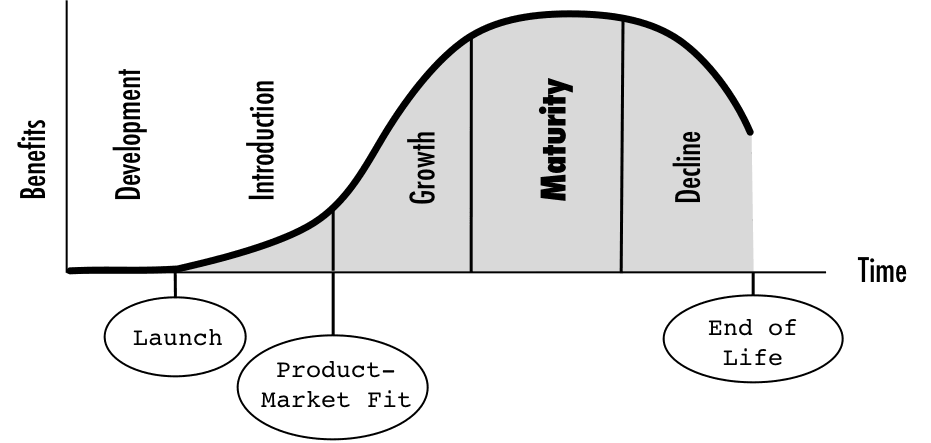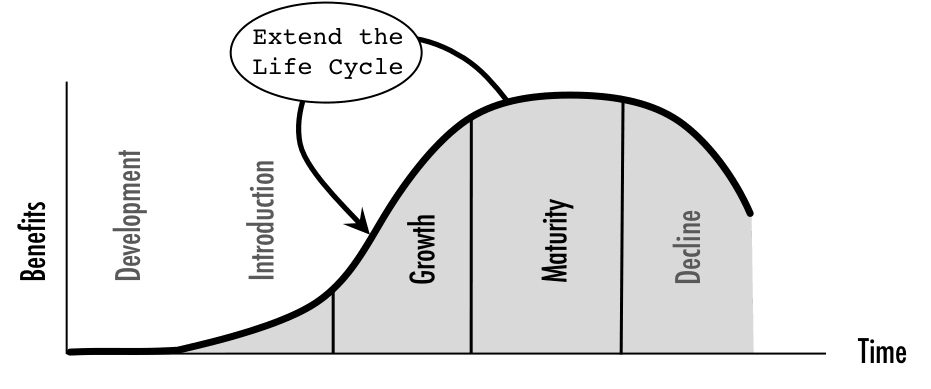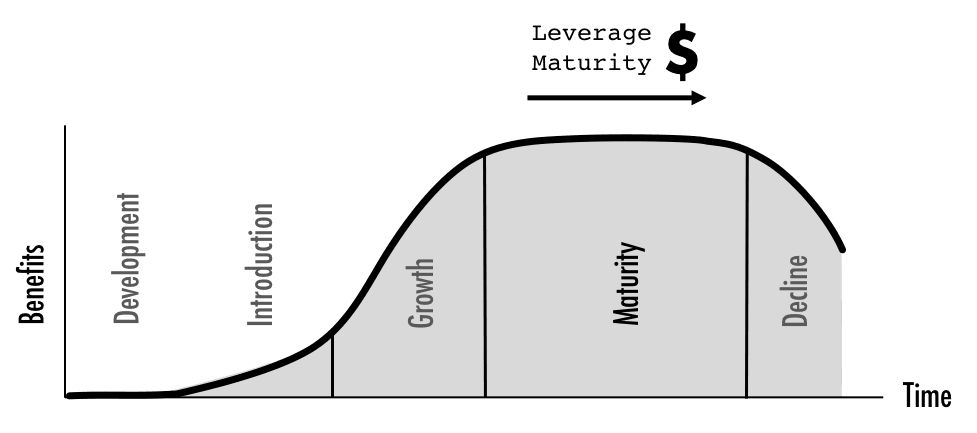Strategic Options for Mature Products
Product strategy does not only matter for new and young products; it is equally important for older ones. This article discusses two main choices for mature products: extending the life cycle and revitalising the product, or leveraging maturity and turning the product into a cash cow.
What Maturity Means
A product is mature if it has stopped growing: The benefits it creates no longer rise. Instead, they have started to stagnate. In terms of the product life cycle model, the product has left the growth stage and entered maturity, as the following picture shows.
To find out if your product is mature, you should track its performance. To do so, you must be clear on the value it creates for the users and business. A tool like my Product Vision Board can help you with this. Next, select the right key performance indicators (KPIs). These might include revenue, cost, profit, market share, engagement, net promoter score, and cancellation rate, for instance. Then measure how much value your product creates. If the data shows a largely flat performance over the last few months, then the product is likely to be mature.
Ideally, you should continuously track the product performance and regularly review the product strategy—at least once per quarter as a rule of thumb. You should therefore become quickly aware of the fact that the product performance is stagnating and your product is entering the maturity stage—which I regard as an important strategic inflection point. This enables you to be proactive and thoughtfully respond to the change. Note that eventually every product enters maturity; no product can continue to grow forever. The only question is when this will happen.
Option 1: Extend the Product Life Cycle
Once your product has entered maturity, your first option is to move the product back into the growth stage thereby extending its life cycle, as the following picture shows.
A number of techniques can help you make an ageing product attractive again including enhancing its capabilities and adding new features. Take the iPhone as an example. Apple has made considerable changes to the products throughout its life: it introduced apps, increased its size, improved the camera, and added face recognition, to name just a few.
Sometimes, though, the opposite strategy is more appropriate. Instead of adding more features, you may want to remove some and declutter your product. Take Microsoft Word for example. Microsoft has made significant efforts to simplify the application in recent years, thereby making it easier for people to use the product.
Another way to stimulate growth is to take your product to a new market or market segment. Think of YouTube Red, a variant of YouTube, for example. At the time of writing, the product offers advertising-free online and offline viewing of YouTube videos, as well as access to Google Play Music and YouTube Red Original series and films. (At the same time, the move has enabled Google to compete with companies like Netflix.)
Finally, you might consider bundling your product with other offerings to increase its attractiveness. For instance, iOS and Android bundle a mobile operating system with a number of pre-installed apps including a web browser, email client, and maps.
Is Option 1 Right for Your Product?
While rejuvenating the product and moving it back into growth may sound attractive, it is not necessarily the right thing to do for your product. If you should choose this option depends on a number of factors:
- The category the product belongs to continues to be attractive.
- You don’t want the product to turn into a cash cow.
- You are able to invest the time and money required to extend the life cycle.
- The product is not too deep into maturity; its performance has fairly recently stagnated.
- The product health including its code quality is reasonable.
If the product category your asset belongs to has lost its attractiveness, then revitalising the product will be difficult. Take MP3 players, for example. The product category has lost its sparkle; fewer and fewer people own dedicated MP3 players; and most of us use our phones to listen to music on the go. If say Apple wanted to revitalise its iPods, then this would be hard to achieve (unless the company marketed them as niche products similar to turntables).
Additionally, rejuvenating your product only makes sense when you don’t want or need it to become a cash cow. As its name suggests, a cash cow is a product that offers plenty of business benefits while it requires a comparatively low investment. Any product portfolio should contain a healthy mix of younger and older products. It can therefore be advantageous to accept maturity and let your product age gracefully, as I discuss in option 2 below.
Extending the product life cycle also requires time and money: You may have to carry out market, user, and competitor research; you may have to develop new features; and you may have to evaluate new technologies and integrate them into the product, resulting in a significant product discovery effort.
What’s more, the longer your product stays in maturity, the bigger the effort is likely to be: Chances are that the market has moved on while you’ve played a defensive game, doing only what is necessary to secure your product’s current position. Shifting gears, embracing an entrepreneurial mindset, and innovating the product can then be challenging.
Finally, consider the product’s health. How high is its refactoring potential and code complexity? How soft or brittle is the software? How easy or difficult will it be to make the necessary changes? While poor product health is not necessarily a show stopper, it will make a life cycle extension harder and more expensive.
Option 2: Keep the Product in Maturity
The second option is to accept your product’s trajectory, let it continue to mature, and keep it at this stage for as long as possible, as the picture below illustrates.
Accepting maturity means adopting a more conservative mindset and playing a defensive game: You typically want to protect your product’s position without investing too much time and money. This often results in incremental enhancements and bug fixes rather than bigger changes like adding brand-new features.
This approach allows you to turn the product into a cash cow—a product that creates plenty of business benefits while requiring a moderate to low investment. But to be able milk it for an extended period and prevent early decline, you must not become complacent and neglect your product.
Keep an eye on market developments including changes in user behaviour, moves by competitors, and new trends that may affect your product. Continue to track the product performance and regularly check if the current strategy is working. And invest the money required to keep the product beneficial for its users.
Should You Choose Option 2?
The second option is right for you if you don’t need to or if you can’t rejuvenate the product: New products are in the pipeline that can eventually replace your product, which are also referred to as question marks and stars, or you are able to secure new products through an acquisition.
Alternatively, the effort to extend the lifecycle is just too big. This may be due to the product category losing its attractiveness, the product having been in maturity for too long, and / or poor code quality.
At the same time, you are happy to turn the product into a cash cow maximising the value it creates for the business while carefully managing the investment required.
| Published on Java Code Geeks with permission by Roman Pichler, partner at our JCG program. See the original article here: Strategic Options for Mature Products Opinions expressed by Java Code Geeks contributors are their own. |







